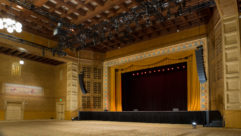
Screens Contributing More to Install Success
Oct 26, 2006 12:00 PM,
By John McKeon

If projectors have been a major arena for technological innovation in recent years, AV integrators and their corporate clients shouldn’t overlook another area in which new technologies and new products are helping to get more performance out of their display dollars: projection screens.
In the past year, virtually all of the leading screen manufacturers have introduced new and/or enhanced products designed to make projected displays look better than ever, often in more flexible configurations and at lower cost than previous models. High gain screens, for instance, offer a strategy for getting more apparent brightness from fewer lumens—that is, a chance to spend less on a projector and still get striking results. Gain refers to the ability of a screen to actually add brightness to the image it reflects back to the audience.
Vutec, for instance, offers in its SilverStar line a group of screens whose gain enables clients to achieve high contrast and good black levels despite the challenges of ambient light. This capability eases the necessity to draw shades or otherwise control lighting in a projection venue—which can be critical in a business environment like a conference room.
Screens are also reaching the market these days in an impressive and growing range of dimensions. As in so many other areas, the rapid spread of high-definition video is driving new screen developments. Manufacturers are delivering more wide screens, up to 200in. NTSC diagonal and 184in. diagonally for HD applications.
Often, these screens go beyond the traditional one-piece configurations. Some new projectors deliver high definition images in the true CinemaScope aspect ratio of 2.35:1, and new projection screens are ready to accommodate these images without the shadows usually associated with curved, ultra-wide screens.
Today, most business applications continue to rely on the traditional 4:3 aspect ratio, and probably will do so until Microsoft moves its ubiquitous PowerPoint software to a wider format. Even using this standard size, though, today’s projection screens are being used in more flexible ways than ever.
Products like the Microperforated screens from Stewart Filmscreen enable screens to overlay sound sources and still allow full, high-quality audio to penetrate. Similarly, motorized screens can be specified for more limited spaces, disappearing into the floor or ceiling when not in use. Many screens are also mounted on devices that enable the entire screen to move in a variety of ways to accommodate user needs.
These days, it may even be too limiting to think of a screen as an opaque surface. New transparent projection screens enable viewers to see a clear image on screen—and see through the screen as well. Draper says that with its entry in this niche, the HoloView screen series, “The image appears to float in space and will stop prospective customers in banks, showrooms, stores, and tradeshows.”
A basic screen decision, of course, is still front projection versus rear. Rear projection is preferred in settings where ambient light is likely to be a challenge and where ample room exists to accommodate the projector’s throw distance behind the screen. Even this distance, though, is increasingly flexible as an array of mirror systems are available that enable projectors to achieve big images in tight spaces.
Every year brings highly publicized rounds of innovation in projectors, flatpanels, and other areas. But progress in projection screens also continues, and often contributes as much to the client’s success as any of these other elements.










